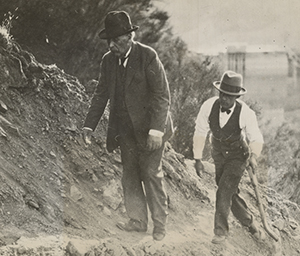BITE-SIZED HISTORY
Published in Issue 4 (July/August 2019), News, Volume 27BY TONY CANAVAN
Don’t mention the war, massacres or mutiny

Above: Belfast-born William Mulholland (left) inspecting the St Francis Dam near Los Angeles in March 1928. (Watson Family Photo Collection)
The British government is having problems with its advisory board on commemorating the First World War. Some members of the board believe that the centenary commemorations should be extended to mark other centenaries. The group, set up under David Cameron, advised on four years of commemorations of the war, ranging from traditional events at the Cenotaph to beachside tributes conceived by the director Danny Boyle. Some members want to extend the official commemorations to address issues such as the role of British forces, including the Black and Tans, in the Irish War of Independence, as well as the 100th anniversary of the Jallianwala Bagh massacre in Amritsar. It seems that even the Treaty of Versailles is causing the British government problems. Some advisers believe that a whole range of issues arising from 1919 ought to be debated and marked, such as mutinies in the armed forces or race riots in Cardiff when black seamen were attacked. It seems unlikely, however, that any of these will ever be officially commemorated by the British State.
Blue plaque honour
Belfast-born engineer William Mulholland was recently honoured in his native city for his critical engineering work, which changed the face of California. Mulholland played an integral part in building the record-breaking Los Angeles aqueduct, which provided so much water to the city that it allowed LA to become the biggest urban centre in California. His pioneering engineering methods became widely adopted, and he is still remembered in LA through the names Mulholland Drive, Mulholland Dam in the Hollywood Hills, Mulholland Highway and Mulholland Middle School. Born in St Patrick’s parish, his Ulster History Circle blue plaque was unveiled there by Deputy Lord Mayor of Belfast Emmet McDonough-Brown, who declared that Mulholland’s contributions to the engineering world will ‘last into the ages’.
Where’s the party?
I had planned for this issue’s Museum Eye to cover Marching on the Road to Freedom: Dáil Éireann 1919 in the National Museum, Collins Barracks. This opened with some fanfare earlier this year and it was a half-page article in a national newspaper that made me want to review it for History Ireland. Imagine my surprise when I arrived at Collins Barracks to find one display cabinet containing six artefacts. On inquiring at the desk, I was told by an embarrassed employee that, yes, that was the whole exhibition. Now, what is on display is of importance and is interesting, as far as it goes, but does it do justice to the establishment of Dáil Éireann in 1919? I think not. This was a momentous moment in modern Irish history and of significance in the historical context of emerging states in Europe at the end of the First World War. Does this event not deserve to be commemorated, if not celebrated, by our National Museum with something more than a single display cabinet?
James Connolly interpretive centre
A new James Connolly interpretive centre in West Belfast—Áras Uí Chonghaile—opened recently, not far from where the man himself lived. A former tanning salon and post office, the reimagined and extended building on the Falls Road has a modern exhibition space, coffee shop, library, mini-theatre and multifunctional conference centre. It aims to tell the well-known story of James Connolly, republican icon and trade union activist, but also the unknown story of his life. This new attraction cost about £1.5 million and hopes to be on the ‘must see’ list for an estimated 20,000 visitors annually. The project has been funded by Belfast City Council and the US trade union movement (Connolly lived in America for eight years). Nineteen trade unions from the US all pledged financial support, amounting to over half a million dollars. The new centre is home to several rare artefacts relating to Connolly, including photographs and original publications, such as a 1935 hardback copy of a book written by Connolly’s daughter Nora, a collection of pre-1916 pamphlets relating to different labour campaigns and previously unseen photographs of his time in America. Áras Uí Chonghaile joins an already existing tourist trail in West Belfast, which includes popular taxi and walking tours.
Lusitania hand-over
The owner of the Lusitania, American Gregg Bemis (see HI 23.6, Nov./Dec. 2015), has transferred ownership of the wreck to the Old Head of Kinsale Lusitania Museum Committee, which plans to build a commemorative museum on the nearby Old Head of Kinsale. Mr Bemis acquired the wreck of the Cunard liner in the 1960s, giving rise to a dispute with local interests who wanted to preserve it for posterity. Speaking at the hand-over ceremony, he said: ‘I’ve come to realise that, at almost 91 years old, there is only so much more I can do to further this project, and I think because of the Lusitania’s part in history it’s very important that it be done properly and we get all the artefacts we can from the wreck to put in the museum planned for here’. The Old Head Committee say that design work on the museum has to be finalised but they estimate that it will cost €3m to build and a further €1m to equip with interactive features to tell the story of the sinking of the Lusitania. The ship was sunk by a German submarine on 17 May 1915 with the loss of 1,201 lives (including three German stowaways). Controversy has always surrounded the event, which played a major part in shifting US opinion towards engagement in the First World War.
















